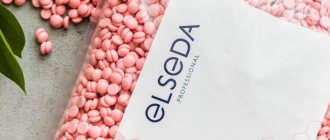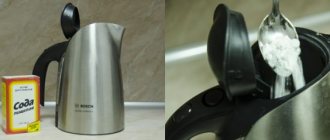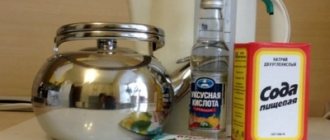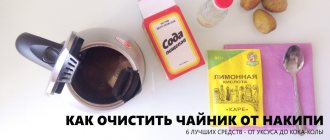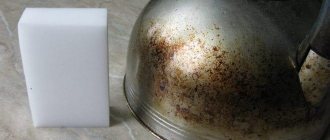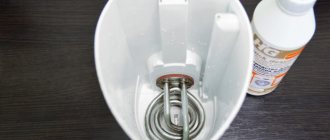In the daily pace and routine of household duties, housewives often forget about something very important. It happens that they even forget to remove the kettle from the stove. Then trouble happens, and a terrible black coating forms on it. Don't panic and throw away your favorite dishes. There are a number of ways to clean a burnt kettle.
Burnt kettle.
How to clean a burnt kettle and how to clean a kettle from scale and carbon deposits.
If the kettle accidentally burns out or becomes covered in carbon deposits due to its proximity to pots and pans on the stove, it can be saved. To do this, you will need a large-volume saucepan or tank so that the long-suffering kettle fits in completely. For 5 liters of water, take 100 g of soda and 100 g of soap shavings (only laundry soap will do). For extra passion, squeeze a little PVA glue into the mixture. Place all this in the container in which the kettle will be brewed, put this item there and put it on low heat and boil for an hour, adding water if necessary. The decoction will turn out “soothy.” Wait until the “soup” has cooled down, remove our hero from it and wash it, and you can pour out the “broth” - it has done its job.
An aluminum kettle can also burn out. It's even easier to revive him. Go to the pharmacy and buy a couple of standards of activated carbon. Remove the tablets, crush them and rub the teapot with the resulting powder. Wait half an hour, wash everything off with a sponge.
How to descale a kettle
- Vinegar. Suitable only for stainless steel kettle. The table variety is bred in a ratio of one to nine, apple - one to six, wine - one to three. This mixture is poured inside and waited. If the scale comes off, that’s enough; after 20 minutes, all that’s left is to wash it. If the vinegar does not scale, you need to boil it. At the same time, your respiratory organs should be protected from harmful fumes.
- Lemon acid. Less harmful to health and gentler on dishes. You can even clean an electric kettle with it. Pour a bag of lemon juice into the bottom, dilute with water, wait 20 minutes, rinse. If scale remains, repeat the procedure, this time bringing the water to a boil.
- Fruits. You can use them entirely or take only unnecessary cleanings. To descale a stainless steel or electric kettle, you can put a lemon cut in half in it, add water and bring it to a boil. Instead of lemon, apple peelings are often used.
- Brine. Housewives use different recipes for preserving vegetables: with citric acid, vinegar, aspirin. In any case, the brine contains acid. It can be poured into a kettle, boiled, and then poured out. So he will serve double duty.
vsemrecept.ru
What does it come from?
Perishable equipment, white residue on the walls of the kettle or dry skin are just some of the negative consequences of using too hard water . The culprit is two elements - calcium and magnesium. However, this does not mean that they cannot be dealt with at home.
Hard water, which causes limescale, is a common problem in many households across the country. This difficulty occurs at different scales in different geographic regions.
The hardness of an aqueous solution is determined by the geological composition of the rocks through which it flows. The hardness level can be checked in a laboratory, using the services of special companies, or doing the test yourself. And even faster, the presence of impurities in water can be seen at home on kitchen appliances.
High levels of calcium and magnesium can be present in tap water and, when they get into tea or coffee, although they cannot cause significant harm to health , they remain on the walls of the kettle in the form of scale, which is a chalky whitish bark.
Hard water deposits form hard coatings and become an ideal breeding ground for microbes.
Removing scale from the inside allows you to keep the kettle clean, prevents the formation of pathogenic bacteria and reduces the amount of damage to the surface and bottom.
two types of hard water :
- temporarily hard – can be softened by boiling, usually caused by thermally unstable compounds of magnesium bicarbonate and calcium bicarbonate, known as limestone or chalk;
- constantly hard is caused by undissolved compounds magnesium sulfates and calcium sulfates.
The presence of impurities in water is the factor that causes scale to form in a kettle . The residue remains on stainless steel, aluminum, glass - both traditional and electric kitchen appliances.
It appears as a brownish-gray coating on the surfaces of appliances and reduces the functionality of those appliances over time. They become inefficient and contribute to increased operating costs and energy consumption.
Scale as small as 3mm can result in energy loss of up to 30%.
The higher the water hardness, the more difficult it is to remove sediment from the surface; you have to use more detergents, which not only harm the environment, but also the budget. Especially if you need to clean a metal kettle.
Source: scum.su
Cleaning process for stainless steel cookware
Contaminants that appear on dishes are not always amenable to ordinary detergents. The utensils stop shining and become dull. A dense carbon deposit forms on the surface, which is difficult to remove. Over time, a considerable layer of difficult-to-clean salts may build up inside. How to properly wash stainless steel if scratches form from hard sponges and abrasive cleaners:
- It is important to soften and soak old deposits before removal;
- The chromium contained in food-grade stainless steel oxidizes in air, forming a strong oxide film, which preserves the steel from rust;
- If the surface has been nickel-plated, it will fade under the influence of aggressive detergents; it is best to clean it with ordinary soap;
- It is important to wipe clean dishes dry; water causes whitish spots and smudges to appear, they worsen the appearance of the kettle;
- It is not recommended to wash shiny dishes in dishwashers.
It is important to wipe clean dishes dry; water causes whitish spots and smudges to appear, which worsen the appearance of the kettle.
When washing polished stainless steel utensils, you should use linear rather than circular movements so that accidental micro-scratches are not noticeable.
Why do you need to delete?
Scale occurs as a result of the settling of limescale on the internal surfaces of the kettle. Limescale is formed from salts, metal particles, and minerals that are present in any unboiled water, and especially a lot of scale forms in hard water. Humanity has not yet found a means to remove scale so that it can disappear once and for all.
Every housewife periodically (about once every two to three months) notices the appearance of white flakes in the water, a whitish or rusty layer on the surface of the dishes, and stone deposits on the spirals of the electric kettle. This means it’s time to descale again. Why does it have to be removed?
Scale causes significant harm because:
- the boiling time of water is extended, there is no energy saving;
- the heating element may fail;
- the kettle will start to turn off before the water in it boils;
- the water will become cloudy, which will affect the quality of the prepared tea and coffee.
Scale occurs on absolutely all heating elements, and it is false to say that if you use filtered water, there will be no problem.
It will happen, but not so often and that’s very good. Alas, household filters do not remove everything that forms limescale.
Scale particles may fall into a cup of drink, and this will be harmful to human health . To prevent this from happening, you can use special filters - nylon, gold-plated. Their use is not very justified - these filters are very short-lived, they have to be washed frequently, which also reduces their service life.
Source: 7rubrik.com
How to clean scale at home?
Chemicals
You can remove scale using store-bought products. In each department of household chemicals you will be offered a choice of several different products from different manufacturers. Almost everyone has the same name - Antiscale .
What's better? Judging by the reviews, all special descaling products are good, even those whose price is no more than 12-15 rubles.
If you use the product strictly according to the instructions, you will definitely have an effect and you won’t have to rub the kettle on purpose, since everything will come off on its own. Look at each package for instructions on how to apply and the exposure time - based on this, make your choice.
Usually the drug should be added to a kettle of cold water and boiled. After the procedure, the dishes are thoroughly washed. Acid works well against scale, but store-bought methods for cleaning heating elements are not recommended to be used frequently, as acids can damage metal surfaces.
Calgon dishwasher detergent has a unique composition with active ingredients that fight calcified deposits. They are able to soften formations, which will allow you to quickly and effectively clean a glass teapot.
For this purpose, you need to use 1 teaspoon of powder per 3 liters of water. Boil the mixture in the device, pour it out and rinse well in warm water.
You cannot add any of the described compositions to hot water - only to cold water and only then heat it.
It is impossible to predict what the effect of a reaction with boiling water may be, so follow safety precautions in your kitchen. Strong chemicals should only be used with gloves and make sure your eyes are also protected.
Sources: scum.su, 7rubrik.com
Traditional methods
Any housewife knows that no filter can save an electric kettle from scale. And if a thin layer of scale does not cause significant harm, then over time the device will, at best, stop working effectively, and at worst, it will break down completely. Scale and rust inside ordinary appliances - metal or enameled - also does not bring joy.
7 best folk ways to get rid of scale:
- Vinegar (method for metal).
- Citric acid (method for a plastic electric kettle and ordinary kettles).
- Soda.
- Impact method (not for electric kettles).
- Soda (for metal and enameled ones).
- Brine.
- Cleaning.
Quick and high-quality cleaning of dishes without harm to health and the use of “chemicals”. We dilute the food vinegar with water (100ml/1l), pour the solution into a bowl, put it on low heat and wait for it to boil. As soon as the kettle boils, you should lift the lid and check how the process of scale is peeling off from the walls of the kettle.
If the peeling is incomplete, leave the kettle on the fire for another 15 minutes . Next, wash the kettle well, removing all remaining vinegar and deposits.
It is advisable to ventilate the room after cleaning.
It is not recommended to use vinegar for an electric kettle (otherwise the kettle can simply be thrown away), but citric acid is an excellent cleaning aid. Dilute 1-2 packets of acid (1-2 tsp) in a liter of water, pour the solution into a kettle and boil.
The plastic of the kettle will be “renewed”, and the plaque will disappear without a trace, easily peeling off after the acid. All that remains is to rinse our device and boil the water “idle” once.
It is better not to let the kettle get to the point where it requires harsh cleaning, since citric acid is also a rather serious remedy for household appliances.
The ideal option is regular cleansing with citric acid without boiling. Just dilute the acid in water, pour it into a kettle and leave for several hours.
Do you like Fanta, Cola or Sprite? You will be interested to know that these drinks (taking into account their “thermonuclear” composition) ideally clean rust and scale from dishes, and even carburetors from burning.
How? After the “magic bubbles” disappear ( there should be no gases - first let the soda sit open), simply pour the soda into the kettle (to the middle of the device) and bring to a boil. Afterwards, wash the kettle.
The method is not suitable for an electric kettle.
It is recommended to use Sprite, as Cola and Fanta can leave their own tint on the dishes .
Suitable for the most neglected condition . Pour water into the kettle, add a spoonful of baking soda (tablespoon), boil the solution, and drain the water. Next, add water again, but with citric acid (1 tbsp per kettle). Boil for about half an hour over low heat.
Drain again, add fresh water, add vinegar (1/2 cup), boil again for 30 minutes. Even if the scale does not come off on its own after such a shock cleaning, it will definitely become loose and can be removed with a simple sponge.
Hard brushes and metal sponges are not recommended for all types of kettles.
Fill the kettle with water, add 1 tbsp of soda to the water, bring to a boil, then leave on low heat for 30 minutes. Next, we wash the kettle, refill it with water and boil it “idle” to remove any remaining soda.
Yes, yes, you can clean the device with regular tomato or cucumber brine. The citric acid contained in the brine will also help remove scale. The scheme is the same: pour brine, boil the kettle, cool, wash. Cucumber pickle perfectly removes rust from iron salts in a kettle.
“Grandma’s” method of descaling. Suitable for light scale deposits in enamel and metal kettles.
We wash the potato peelings well, remove the sand from them, put them in a kettle, fill them with water and boil. After boiling, leave the cleaning in the bowl for an hour or two, and then wash the kettle thoroughly. And apple or pear peelings will help to cope with a light coating of white “salt” scale.
Regardless of the cleaning method, do not forget to thoroughly wash the kettle after the procedure and boil the water empty (1-2 times) so that the remaining product does not get into your tea. If the residues after peeling with apple peelings do not cause harm to health, then the residues of vinegar or soda can cause serious poisoning. Be careful!
Source: colady.ru
How to clean an enamel pan: 9 home remedies
At home, to wash a burnt enamel pan, place it in hot water for several hours. This will help get rid of the top layer of plaque, which easily gets wet, without harming the surface. Then use a sponge to remove most of the dirt.
The following methods will help you get rid of blackness at the bottom of a pan or ladle:
- The simplest and safest method that will help save a pan from burnt food is to use table salt. The dishes are carefully washed with water and the top layer of soot is removed. Pour 1 glass of salt into the bottom of the container and add 2 glasses of water so that the entire area of contamination is covered with liquid. Then place the pan on low heat and boil for about 30 minutes. After this procedure, the dishes are thoroughly washed in the usual way.
- This method will tell you how to clean a burnt pan using citric acid. The container should be thoroughly washed and a few sachets of citric acid should be poured into the bottom, then filled with water and placed on low heat. This method is good for removing not only carbon deposits, but also scale that forms on the walls of teapots and ladles.
- In difficult cases, many are at a loss as to how to clean an enamel container from a thick layer of burnt food. At home, you can use sand. It will act as an abrasive substance that will remove the ash layer. When using this method, it is important not to rub the enamel itself with grains of sand, otherwise they will scratch it, and in the future any food will burn. Sand is used only to remove a thick layer of carbon deposits. With its help, you can carefully clean the surface of the container.
- In order to save a pan from burnt milk or porridge, just soak it in water and pour baking soda inside. Many housewives wash containers with regular detergent, then add 2-3 tbsp to the bottom. l. baking soda and leave it like that overnight. In the morning, dirt can be easily removed with a sponge and water.
- Housewives often use white to prevent scorching on the pan. It helps restore the former shine and purity of the enamel. You need to work with whiteness with gloves and carefully. This product should not be used to clean dishes used for preparing food for small children.
- Activated charcoal is excellent in combating burnt fat if the pan has darkened or turned yellow after prolonged use. First you need to crush the package of activated carbon tablets. The resulting powder is poured onto the contaminated bottom of the container and left for 30 minutes. Then add a glass of water and boil over low heat. The method removes old stains and black plaque well. It can be used if the jam in the pan is burnt. Activated carbon helps remove such contaminants and does not harm the enamel surface.
- An effective method is the use of mustard for washing enamel dishes. It removes traces of burnt food and soot well. It is advisable to use this substance to remove fresh dirt from enamel cookware. Mustard perfectly whitens the enamel of the pan from the inside and outside. The container must first be cleaned of food residues and ash, after which 2-3 tbsp are poured onto the contaminated surface. l. dry mustard and rub gently with the hard side of the sponge.
- Vinegar at home always comes to the rescue in difficult situations. If fat or food is burnt in a pan, first wash the pan to remove soot and food debris. Then prepare a solution of vinegar and water. Dissolve 4 tbsp in 1 liter of liquid. l. vinegar and pour this solution into the bottom of the pan. Then the container with the solution is placed on low heat and boiled for an hour. During the process, you need to open windows for ventilation and isolate children and animals from inhaling these fumes. After boiling, use a sponge to remove any remaining dirt and thoroughly wash the pan in the usual way.
- Medical alcohol is great for cleaning burnt dishes. It cleans the pan from burning and old fat residues. Housewives prefer to use medical alcohol after cleaning with detergents. It helps restore the shine and whiteness of the metal surface. The burnt bottom of the enamel pan should be rubbed with a sponge dipped in liquid and left for 30 minutes. Remaining fat is washed off with warm water.
We suggest you read How to clean the glossy surface of kitchen furniture
How to avoid scale?
Water hardness affects the condition of kitchen appliances differently depending on the impurity content in it. To avoid having to frequently remove buildup, try some cleaning activities at home:
- Drain the water after each use - storage encourages scale formation.
- Rinse the tank regularly with warm water.
- Use filters to soften your water - if it contains fewer minerals, there is a small chance of sediment build-up.
- Use distilled water for tea - this solution does not contain mineral deposits.
Source: scum.su
How to clean the outside of a stainless steel kettle from grease and rust?
There are many cleaning methods. None of them are worse or better, they will all help clean the dishes you need, the choice is at your discretion:
- Cleaning with baking soda is the simplest and most affordable method.
- Another way to clean the outside is with baking soda.
- Vinegar with soda.
- Another remedy for combating grease on dishes is mustard powder.
- Chemical substances.
It is best to warm up a stainless steel kettle a little before attempting to clean the outside of it. To do this, you can warm it up for a couple of minutes or hold it under hot water.
Afterwards, take a little soda on a sponge and rub all the walls (do not press too hard, soda can also leave scratches). Let it sit for a few minutes, rinse off the soda with warm water, and then rinse with cold water. Wipe with a dry towel.
Instead of soda, you can use tooth powder.
In this case, you need to dissolve 1 tablespoon of baking soda in 1 liter of water. Place the kettle in a container with this solution and put on fire for 20-30 minutes. Then turn off the heat and let cool. After cooling, clean the kettle from any remaining deposits and soda and rinse under water. Very easy and fast, and the teapot is already clean.
The kettle should be almost completely submerged . By increasing the amount of water, you should proportionally increase the amount of soda.
Add 2-3 tablespoons of vinegar and 3 tablespoons of soda to a large container of water. It only takes five minutes to keep the kettle on the fire in this solution, then clean it in the same way as with a simple soda solution. Wait until it cools down, clean with a soft sponge, rinse thoroughly, and wipe dry.
Apply mustard to the warm surface of the kettle and wipe with a slightly damp sponge. Then rinse off the powder under warm water.
There is a varied range of dishes for cleaning dishes (Shumanit, Selena, Chistyulya and others). They all have different compositions, which is also a matter of taste.
There are budget ones, and there are quite high prices, but the number on the price tag should not guide the choice. For example, Shumanite and Selena are inexpensive, but effective, and can easily clean the outside of stainless steel utensils.
Use the chosen product strictly according to the instructions . Apply, wait for the required time, try to remove droplets of fat by wiping the surface with a soft sponge. Rinse thoroughly and rinse the container several times in warm and cold water. Then wipe dry. When using chemicals, never neglect protection. Hands should be gloved, and if possible, wear plastic goggles and a respirator.
Do not use concentrated detergents if anyone in your household is prone to allergic reactions.
Removing rust from a kettle is easy and simple.
If a little rust appears on a stainless steel kettle (it is better to monitor its appearance and remove it as soon as possible), then you can peel it with regular potatoes .
Cut the potato in half and sprinkle salt on the cut area. It is with this cut that you rub the area of rust, then rinse thoroughly under running water.
Baking soda is also effective against rust. It is necessary to dilute it with water to a paste and apply it to the problem area for 20-30 minutes. Afterwards, brush with a toothbrush, remove any residue with a cloth and rinse with water. If the rust has not gone away, repeat the procedure.
If the kettle is rusty
Rusty spots may appear on a metal kettle, both inside and outside. The following question is also relevant: how to clean an electric kettle and even a stainless steel kettle from rust, no matter how paradoxical it may sound. The fact is that in some regions tap water contains iron impurities, and rust forms on the inner surface of the kettle.
To prevent rusty deposits from forming in the kettle, do not leave it filled with water overnight.
To clean rust from the inside, you can use citric acid and a mixture of vinegar and soda (half and half) (in this case it is softer and more effective). The active ingredient, be it vinegar, lemon juice or something else, must be diluted with water. The optimal ratio is a tablespoon per liter of water.
If there is a local stain, you can rub it with potatoes, and then wash it in the usual way. Do not use metal brushes - they will only damage the surface.
How to save a burnt kettle?
If, while doing important things, you forgot that there was a kettle on the stove and it burned out, the following will help you clean it : salt, activated carbon, laundry soap, powder or special products.
Just don’t mix them all together, you need to choose one thing:
- The easiest way to get rid of carbon deposits is soaking.
- By moistening a sponge and dipping it in salt, you can wash off the fumes if the deposit is not too strong. After the kettle has been rinsed with wet salt, you need to rinse it with cold tap water.
- You can clean a burnt kettle using activated carbon.
Dilute powder, dishwashing detergent or laundry soap in water. Soak the teapot in the solution. Leave for a while until the dirt becomes soft, clean with a double-sided sponge with stiff bristles or a soft brush.
Crush several tablets (at least 10), moisten the surface of the kettle and apply the powder to problem areas. No earlier than 40 minutes later, wipe off the soot and rinse the dishes under water.
All of these methods can be used to clean stainless steel pans. Knowing all these methods, you don’t have to worry about the cleanliness of the dishes and the beauty of the kitchen.
Source: hozotsek.ru
Prevention measures
To avoid problems with how to clean the kettle from certain contaminants, you need to handle it correctly. There are a number of measures to prevent the appearance of dirt, grease and plaque. These include:
- keeping dishes clean and cleaning them as needed;
- using only clean filtered water;
- pour out the remaining liquid after boiling;
- putting dishes away for storage if they are not currently in use, especially if something else is being cooked on the stove at that time;
- Do not place an empty vessel on an open fire, and especially do not forget it for a long time.
To prevent the appearance of dirt inside the kettle, boil it with a light soda solution.
How to get rid of the plastic smell in the device?
The new kettle smells like plastic - what should I do? In fact, the plastic itself is odorless, but the kettle smells of dye and plasticizer, which are added in huge quantities to extend the life of the kettle. To get rid of odors, you should use substances that help remove odors from any surfaces.
You will need:
- lemon juice;
- lemon acid;
- lemon peel;
- vinegar;
- soda.
Instructions:
- To remove the smell of plastic from an electric kettle and its taste from drinks, boil the kettle by adding natural lemon juice, citric acid in bags or lemon peels.
- To remove plastic smell using citric acid, fill the kettle with water to the maximum level, pour in 2 25 g bags of acid, boil the kettle, leave the solution overnight, boil the kettle again in the morning, drain the solution, rinse the kettle under running water.
- If you want to use lemon peels, then fill the kettle halfway with the peels, pour water to the maximum level, boil, leave the solution overnight or for at least 12 hours, boil the kettle again, remove everything from it, rinse with running water.
- In addition to these products, you can use vinegar or vinegar essence.
- Baking soda can also help get rid of plastic smells. Fill the kettle with water, add 3 tablespoons of soda, boil the kettle, cool, boil again, drain the solution, rinse the device under running water.
If you add lemon juice, then squeeze the juice from 3-4 lemons, pour into the kettle, add water to the maximum mark, boil, leave the solution for 12 hours, boil again, drain the solution, rinse the kettle with running water. Repeat the procedure if necessary.
To do this, pour water into the kettle, add 2 tablespoons of 70% vinegar essence (or half a glass of 9% vinegar), heat the kettle, but do not bring to a boil, as when boiling the solution will float out (a chemical reaction occurs), that is, it will pour over the kettle . Heat it several times, drain the solution, and rinse the kettle under running water.
Source: kakprosto.ru
kachestvolife.club
Traditional ways to clean the outside of a stainless steel kettle
In order to clean the outer walls of a stainless steel kettle from various types of contaminants, use such improvised means as:
- toothpaste;
- table vinegar;
- baking soda.
Important! Stainless steel cookware does not tolerate the use of abrasives.
Toothpaste is intended for simple stains and is also used as a polish for dishes. To clean kitchen utensils, you will need to apply a small amount of paste to a soft sponge. Then, rub the outer walls in a circular motion. Finally, wash the utensils under running cool water and wipe the kettle with a dry, lint-free towel.
Table vinegar is used in two ways. The first involves applying the product directly to the surface to wash off the burning outside. In the second case, a strong solution is used to clean the inner surface of the kettle. Vinegar is an excellent tool for removing grease stains and limescale. To do this, pour table vinegar diluted with water in a 1:1 ratio into the dish and leave for 2-3 hours. During this time, the scale will become soft and easy to remove.
For external grease cleaning, it is recommended to apply vinegar to a soft, clean sponge and wipe the surface. Then, rinse off under running water.
Baking soda is also used in two ways to clean the outside of a stainless steel kettle. In the first case, the product is applied to the outer walls of the utensils and cleaned with a sponge. The second option is used for heavy carbon deposits and grease contamination. Pour ⅟₂ packs of soda into a large saucepan and pour in water. Turn on the slow fire mode. Then, a kettle is placed inside the utensil so that the water reaches the neck of the utensil. Boil for an hour. To enhance the effect, dishwashing detergent is added to the water.
Note: in a similar way, you can clean enamel kitchen utensils from old stains.
How to clean an enamel pan: 9 home remedies
Scale is not the only threat to the cleanliness and proper operation of kitchen appliances.
Often unsightly stains appear on metal utensils, and the question arises: how to clean the outside of the kettle without damaging the surface?
This is where baking soda can help:
- Dissolve 2 tablespoons in a liter of warm water.
- Then use a sponge to thoroughly but gently clean the surface.
- Then rinse off the remaining product with cold water.
It is also recommended to use toothpaste for cleaning - it does not scratch the metal surface, although it does not hurt to first test on a small area how such a product will affect it.
Various kitchen cleaners without abrasives are very helpful in getting rid of stains.
Grease stains on the surface are a common problem for both electric and regular kettles.
If it is not possible to remove appliances while preparing food to prevent grease from flying onto foreign surfaces, modern grease cleaning products will come to the rescue, of course, without abrasive particles.
The same products that are used to remove carbon deposits from a frying pan, wash microwave ovens or clean irons will do.
Descaling the inside of a stainless steel kettle
The water in the pipes is not soft unless a filter has been installed. Due to this, a deposit of boiled water forms on the kettle. To reduce the amount of limescale deposits, it is recommended to use purified water.
To remove plaque from the kettle and drink hot drinks without heavy metals, you can use proven folk methods.
Table vinegar
Equally suitable for cleaning the kettle from limescale and to effectively wash the kettle of grease. To do this, you will need to pour bite diluted in water into a bowl in equal proportions. Boil for 1-2 hours, then turn off the heat. After the specified time, the plaque will soften and can be removed with a brush or sponge with a hard base.
Important! If you boil dishes with table vinegar for longer, you need to open the windows and leave the kitchen, because. fumes from the product are harmful to health.
Lemon acid
A harmless product with an effective effect is used as follows: fill the entire kettle with water and add 2-3 packets of citric acid. Mix. Turn the stove on to medium heat and simmer for 2 hours. Then, let the dishes cool and turn on the heat again - boil for another 2 hours. Allow the container to cool completely. After this, rinse the kettle under running water.
Carbonated drink Coca-Cola
The drink contains orthophosphoric acid, which allows you to eliminate moderate limescale deposits in a matter of minutes. For more severe stains, 2-3 procedures will be required.
Note: Coca-Cola can be used for electric kettles.
Soda is poured to the level of contaminants and then boiled for an hour. After the utensils have cooled, drain the drink and remove any remaining residue with a sponge. Finally, rinse thoroughly under water.
Baking soda and table vinegar
This combination of products can only be used for utensils made of metal materials, because... When used on electrical equipment, it can cause damage.
Instructions:
- Pour water into the kettle with the addition of baking soda at the rate of 1 liter per 1 tbsp. spoon.
- Place over medium heat and simmer for 30 minutes.
- Pour out the solution and, without rinsing, fill the container with a solution of water and table vinegar in the proportions of 100 ml of vinegar per 1 liter of water.
- Boil for 30 minutes.
- Wait until the dishes have cooled, drain the solution and wipe with a sponge.
If the limescale is old, it is recommended to add citric acid. After the procedure of boiling the solution, you should add acid in similar proportions as soda and bring to a boil. After this, move on to the vinegar solution.
Cucumber pickle
A simple but effective remedy for cleaning minor scale is cucumber pickle. Due to the fact that it contains vinegar, it cannot be used on electrical equipment. Pour brine from a cylinder into a stainless steel kettle and boil for 30 minutes. After this, rinse under running water.
Curdled milk or sour milk
Sour milk does an excellent job of removing scale and other contaminants in both a stainless steel and electric kettle. The method is easy to use - pour liquid into the utensils and bring to a boil. Afterwards, wipe thoroughly and wash with dish soap and rinse under running water.
After using any method, it is recommended to pour water into the kettle and boil it twice. This will get rid of odors and detergent residues.
To restore the shine of stainless steel utensils, just use citric acid or lemon. To avoid the formation of severe scale, experts advise using any cleaning option once a month as a preventive measure. This makes it possible to keep the dishes clean and safe to use.
An effective method for cleaning a burnt kettle
In situations where the kettle has burned out and you cannot use a metal mesh, the following option without the use of chemicals comes to the rescue:
- 80 g silicate glue;
- 100 g baking soda;
- 10 l. water.
Mix the ingredients in a large container and load the kettle. You can use either a pan or a bucket. Boil for 20 minutes. Remove any remaining soot and carbon deposits with a hard bristled sponge.
To clean a burnt kettle from the inside, it is important to act immediately, because... the bark contains high levels of carcinogens. When the soot has not seriously damaged the dishes, it is enough to fill it with dishwashing detergent, having previously diluted it in water. Leave the utensils overnight and then wipe off any remaining residue with a sponge.
mamamoet.ru
Quick cleaning method
The main thing to do if an enamel pan is burnt is not to put off cleaning until later, but to act immediately. Blackened dishes must first be soaked completely in warm water. It is left for 1-2 hours, after which the black plaque is washed off using detergent and a sponge. This method is suitable if the degree of burning is low. In more complex cases, it is necessary to use special cleaning compounds or resort to traditional methods.
Here's a way to clean an enamel pan from dark deposits: you need to carefully remove any remaining burnt food with a sponge and fill the dish with hot water and soda. It is left in this solution for a couple of hours. Then the liquid is drained, 1-2 tbsp is poured onto the bottom of the container. l. baking soda and use a sponge to effortlessly remove carbon deposits. This method also helps to get rid of yellowness on the enamel surface. Baking soda or fine salt can gently clean such stains.
With any method of cleaning a pan from carbon deposits, it is important to use a medium-hard sponge, a synthetic brush and acid-free chemical compounds. These conditions are important because enamel is a fragile and thin material. It can be damaged by sudden temperature changes, shocks, or prolonged exposure to temperature.
In order for dishes made from this material to last a long time, it is necessary to use it correctly.
It is not advisable to boil milk or sauté vegetables in an enamel pan. It is not used for cooking in the oven.
If black deposits form, the container should be soaked in water and detergent.
Super remedy for severe soot
Almost all housewives know that it is difficult to wash heavily burnt enamel dishes. But there are special tools that can help in this matter.
At home, you can clean a heavily burnt cup or ladle using vinegar, baking soda and water. These components are mixed, placed in a container and boiled. After which the dishes must be washed with a medium-hard sponge and water.
You can use cleaning agents that are sold in household chemical stores and are created specifically for washing enamel surfaces. They remove old fat, carbon deposits and soot that remain in a frying pan, kettle or saucepan.

